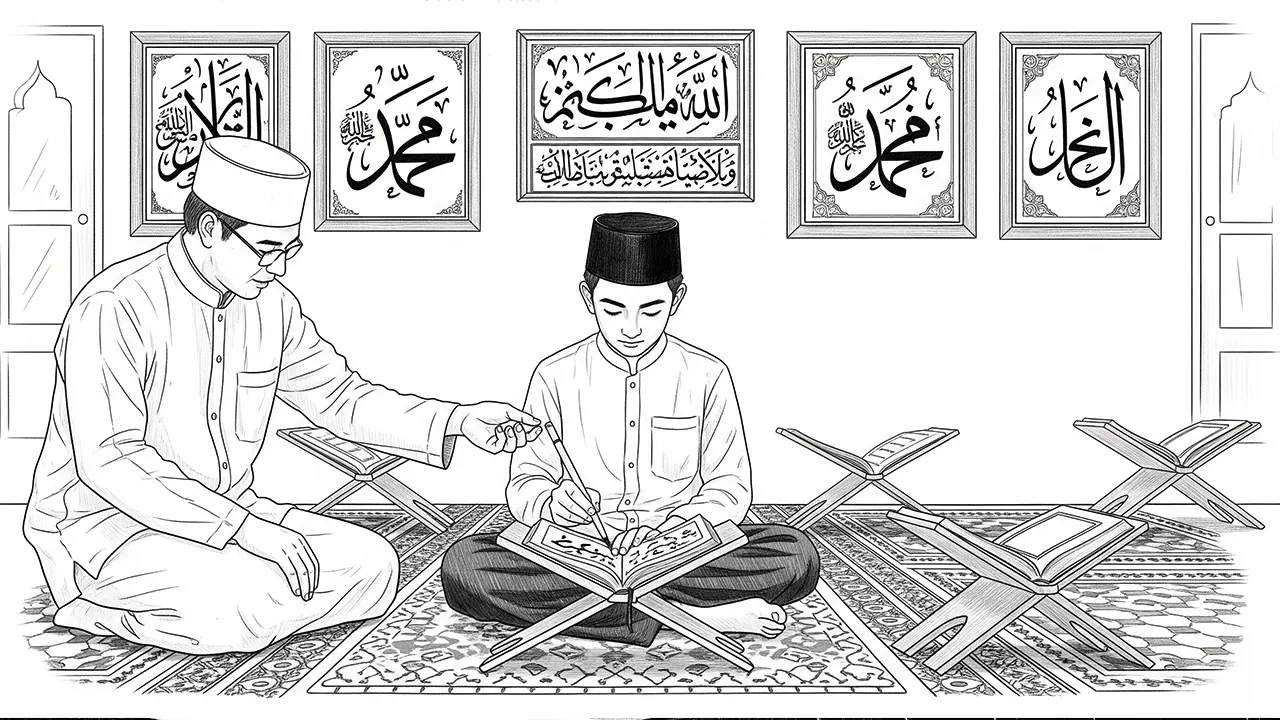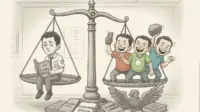The development of writing skills holds essential relevance in language education, especially for students aiming to articulate their understanding of religious texts, academic works, and everyday communication.
Without strong writing capabilities, students may struggle to present ideas systematically and in a manner that others can understand. Therefore, enhancing writing skills should remain a central focus in Arabic language instruction, particularly in Islamic educational contexts.
Arabic, being the foundational language of Islamic studies, holds a prominent role in the national education curriculum, particularly in madrasahs and Islamic boarding schools across Indonesia. Within the Arabic language learning framework, students are expected to master four core skills: listening (istima’), speaking (kalam), reading (qira’ah), and writing (kitabah).
Among these, maharah al-kitabah writing tends to be the most complex. It requires not only cognitive understanding but also fine motor coordination and aesthetic awareness. Writing Arabic involves mastery of letter shapes, proper placement within words, and understanding the right-to-left writing orientation.
To address these challenges, the incorporation of calligraphy (khat) as a learning tool offers an effective and culturally rich solution. Calligraphy not only trains students in the technical aspects of writing Arabic but also introduces them to the artistic beauty and discipline that the Arabic script demands. This dual focus technical and aesthetic makes calligraphy a powerful medium to improve Arabic writing skills.
Enhancing Writing Through Structured Calligraphy Training
An illustrative example can be found in a recent three-day calligraphy workshop held at an Islamic boarding school in Manado. Each day of the workshop focused on different components of the calligraphy learning process, offering a well-rounded experience for participants.
On the first day, students were introduced to essential calligraphy tools, the rules governing Arabic letters, and the structure of various script models. They engaged in hands-on practice with hijaiyah letters using calligraphy pencils, guided by live demonstrations from instructors.
On the second day, the focus shifted to writing connected hijaiyah letters and constructing words and short sentences. This stage helped students understand the flow and proportion of Arabic writing. On the third day, students advanced to creating ornaments and coloring asmaul husna calligraphy, applying their learning in a creative and meaningful context. By the end of the training, students not only grasped the fundamental techniques of Arabic writing but also began appreciating the artistic value embedded in the script.
From this short training session alone, it became evident that the integration of calligraphy in Arabic instruction could significantly boost students’ interest and motivation. My personal experience resonates with this.
I had the opportunity to study at a specialized calligraphy pesantren for one full year. The training was rigorous and artistic outcomes were tangible ranging from pieces on canvas, mosque walls, schools, and prayer spaces, all reflecting the spirit of Islamic calligraphy.
Arabic Calligraphy: A Link Between Writing Skills and Cultural Heritage
Arabic calligraphy is more than a set of ornate scripts. It represents a bridge between linguistic function and Islamic cultural identity. The learning process goes beyond recognizing styles like Naskhi, Riq’ah, Tsuluts, and Diwani.
It involves understanding the philosophy of proportion, symmetry, and the spiritual meanings behind each curve and stroke. Students are encouraged to develop their artistic intuition while mastering the use of specialized pens (kalam) and ink.
Through this practice, they not only refine their technical skills but also begin to internalize the spiritual and philosophical depth behind the language. The symbolism of each letter and the historical reverence of the script used in Qur’anic verses and mosque architecture enrich students’ connection to their faith and heritage. Arabic calligraphy, therefore, is not merely visual art; it is a sophisticated pedagogical tool that cultivates discipline, attention to detail, and cultural appreciation.
Barriers to Effective Calligraphy Education
Despite its benefits, the widespread adoption of calligraphy in Arabic education still faces several challenges. One of the most pressing issues is the limited inclusion of artistic approaches like calligraphy in the mainstream Arabic curriculum. Many programs remain overly theoretical, leaving little room for hands-on or creative expression.
In addition, the scarcity of appropriate learning resources such as textbooks tailored to students’ developmental stages significantly limits the effectiveness of calligraphy instruction. Moreover, perceptions among educators and parents often underestimate the role of calligraphy. It is still largely seen as a hobby or extracurricular pursuit, rather than an integral element of language mastery.
Teacher competence also poses a hurdle. Not all Arabic instructors possess the training to teach calligraphy proficiently. Supporting facilities such as practice books, special pens, and high-quality paper are still insufficiently available in many schools.
Furthermore, students often encounter difficulties adjusting to the nuances of Arabic script directionality, alignment, and balance. Some even view calligraphy as a talent-dependent discipline, which can lead to a lack of motivation before they begin.
The Role of Government and Institutions
Addressing these systemic barriers requires the proactive involvement of educational institutions and government bodies. A multi-pronged approach can be developed to strengthen calligraphy instruction.
Firstly, training programs should be regularly conducted to equip teachers with effective pedagogical strategies for teaching calligraphy. Secondly, schools should allocate budget and resources to procure the necessary tools quality pens, practice books, and visual references.
The integration of technology also offers promising possibilities. Digital applications and platforms for learning Arabic calligraphy can make the process more accessible and engaging. Furthermore, organizing calligraphy competitions, exhibitions, and workshops can serve as motivational platforms that both showcase student talent and celebrate cultural heritage.
Additionally, higher education institutions can take the lead in formulating standardized teaching guidelines and curriculum models suitable for implementation across different education levels. Offering scholarships or certification programs for aspiring calligraphy instructors can ensure a pipeline of trained professionals capable of elevating Arabic education in Indonesia.
Fusing Aesthetic and Character Values Through Calligraphy
In today’s globalized era, where local identities often risk erosion, calligraphy plays a vital role in preserving and promoting Islamic cultural values. It serves as a bridge between tradition and modernity, empowering students not only to master the Arabic script but also to internalize the values of patience, precision, and perseverance.
Calligraphy is not just about beautiful writing; it instills character. The patience required to perfect a single letter, the meticulousness in aligning proportions, and the discipline in practicing regularly all contribute to character development. These soft skills are invaluable in broader academic and personal contexts.
The practice of calligraphy encourages mindfulness and appreciation for detail, reinforcing both academic excellence and cultural identity. It is essential, therefore, that calligraphy be viewed not just as a form of decoration or artistic hobby but as a transformative educational tool. When embedded meaningfully into the Arabic language curriculum, calligraphy becomes a vehicle for holistic learning—enhancing writing ability, cultivating aesthetic appreciation, and nurturing Islamic values.
Conclusion
Calligraphy is more than an artistic form it is a deeply rooted Islamic tradition that fosters linguistic, cultural, and personal growth. By integrating calligraphy into Arabic language education, we not only enhance students’ technical writing skills but also instill in them a profound respect for their heritage and faith.
The future of Arabic literacy depends not only on grammatical proficiency but also on the ability to appreciate and preserve the cultural and spiritual richness of the language. For this reason, the inclusion of Arabic calligraphy in formal education should be prioritized, promoted, and refined ensuring it becomes a pillar of comprehensive Arabic language mastery for future generations.
Supervisor : Dr. Iman Sastra Mihajat Ph.D








